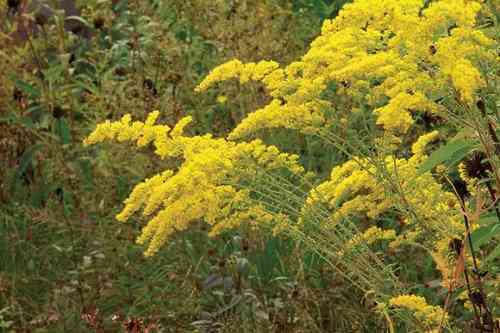Your cart is currently empty!
Grey Goldenrod
Photo:
Frank Mayfield, via Wikimedia Commons
Goldenrods are a type of herbaceous flowering plant in the Asteraceae family, also known as the Compositae. Although the plant starts out green, the stem eventually turns grey-green and the plant as a whole turns golden with yellowish flowers. This perennial wildflower is also known as grey-stemmed goldenrod, probably due to its appearance.
When you look at a “flower” of these plants, you are actually looking at a cluster of literally hundreds of flowers. You will have to look closely to see that the individual flowers are tiny little things (called florets—meaning little flowers) only a few millimeters in diameter. Individual flowers are usually grouped into larger aggregates called, appropriately, heads. Heads are grouped into still larger structures called inflorescences.
Quick Growing Guide

Botanical Name: Solidago nemoralis
Also Called: Common goldenrod, gray goldenrod, old field goldenrod
En français: Verge d’or des bois
Colour:
Sun / Shade:
Water: Prefers dry soil
Height:
Pollinators:
Other common names of this plant are common goldenrod, old-field goldenrod, field goldenrod, prairie goldenrod, and dyersweed goldenrod. The plant is very small, with its height ranging from 20 cm to 1 meter, which people also call dwarf goldenrod.
Grey Goldenrod, like many other goldenrods, can be found in meadows and fields throughout North America, in almost every state and province. The Canadian province of Newfoundland and Labrador, on the other hand, is an exception.
It generally thrives on dry soil under scarce rain conditions. Multiple stems arise from its roots, at the top of which there are clusters of flowers. An inflorescence can contain upto 300 flower heads, and a single flower head have a large number of ray and disc florets.
Appearance
The upright, short, and multiple-stemmed wildflower plant is one of the smallest of the goldenrods. Its stems and leaves are covered with tiny hairs. They are green in color when young but turn reddish to grey-green as time goes by.
Leaves are simple and are not differentiated into small leaflets. The leaves are arranged in such a way that there is only one of them per node along the stem and are alternate. There may or may not be teeth on the edge of the leaf blade.
The lower leaves are comparatively larger than the upper leaves and are upto 10 centimeters long. The upper leaves are shorter, narrower, and devoid of petioles. However, the larger lower ones are connected to the stem via winged petioles.

Flowers and Fruit
The golden-colored or yellowish wildflowers are arranged all over the top of the stem. Each grey golderod flower head contains around ten disc florets in the center and about 5 to 11 ray florets which are almost strap-shaped and are located around the disc florets.
The flowering usually occurs between August and November on the upper part of hairy stalks, which are directed out and downwards, resulting in vase-shaped clusters of flowers. They mainly bloom during the fall season, and it lasts for about a month.
The floral scent is usually absent, but in some cases, the flowerheads may have a slight fragrance. As the blooming period becomes over, hairy achenes replace flowerheads.
Its fruit is very small, about 2 mm in length but with a long tip. The fruit is of rough-textured cypsela type containing a pappus, and its seeds are dry.
Habitat and Range
Grey Goldenrod require dry soil with little or no rainwater supply after germination. There is no specificity regarding the light requirements. Drought-tolerant, it can grow in areas with direct sunlight as well as shady and partially shady conditions. It is a native plant of Southern Canada and much of eastern North America, from the Rockies to Durango, Colorado, in Northern Mexico. It grows well in open woods, forests, grassland, upland prairies, and along roadsides.
This plant can grow and increase its numbers in a very short span of time, and because of its weed-like nature, the plant is often considered troublesome. It can be found widespread in both degraded and higher quality soil areas.
Propagating Grey Goldenrod
The native North American herb can easily grow and propagate from its seeds. The stratification of its seeds can be of great help if one wants to cultivate it, but it is not compulsory. However, using fresh seeds is preferred.
Because of its spreading rhizomatous growth and self-seeding, it is not typically planted in formal or managed garden settings. Plants form unremarkable mounds of green foliage until the flowers burst into bloom in late summer. Meadows, wild gardens, and cottage gardens are examples of naturalised gardens. It can be invasive when competing with many other plants; on the other hand, it can be a good choice for difficult areas with poor soils where other types of plants are difficult to grow.
Generally, the month of October is most favorable for seed collection.
Besides, this species can also be propagated by the separation of the already matured plant. However, one must be sure that each divided section necessarily has a bud and a root.
Benefits
As the Grey Goldenrod flower is pretty attractive, large varieties of insects are attracted to it, which helps in pollination. The most common visitors are carpenter bees, honey bees, sweet bees, wasps, butterflies, flies, etc.
Other insect species, like leaf-footed bugs, goldenrod scarlet plant bugs, etc., survive by feeding on its foliage.
Besides, it has medicinal use as well. The native North American people use it to cure jaundice. Similarly, the native tribes, such as the Goshute and the Navajo, use its seeds for food and incense.
Share with Family and Friends
Featured Authors
Visit a Botanical Garden For Unique Experiences.
Comments
Logging in to comment gives you more features, but it is not required.
Subscribe
0 Comments
Oldest













